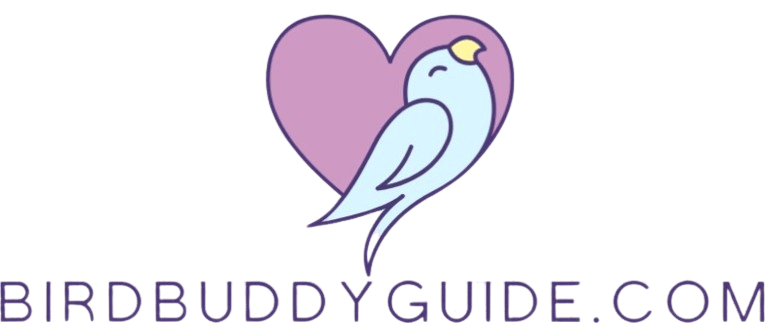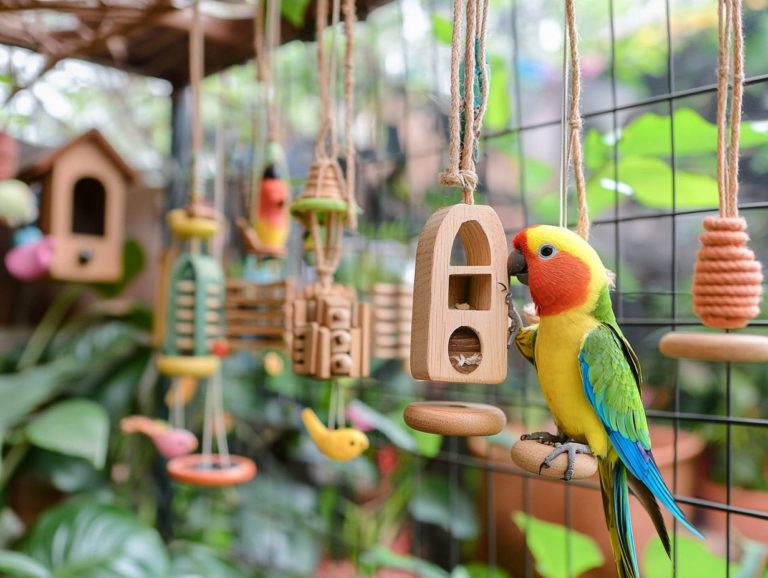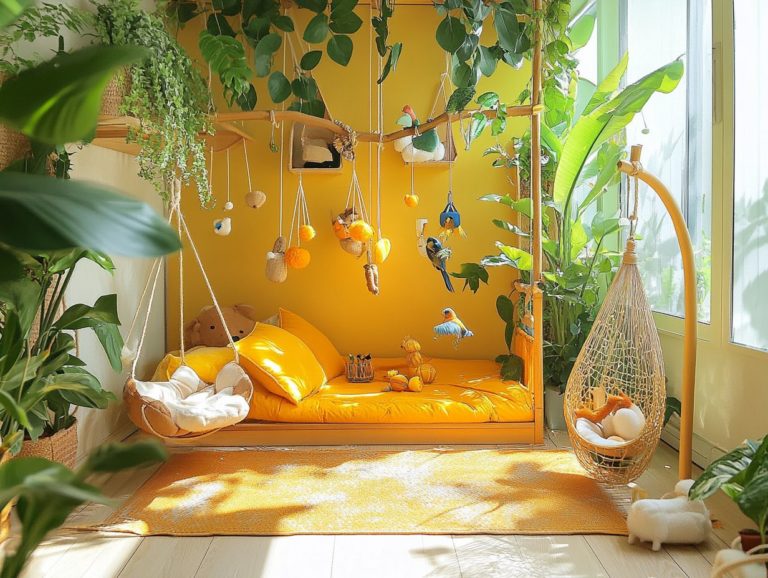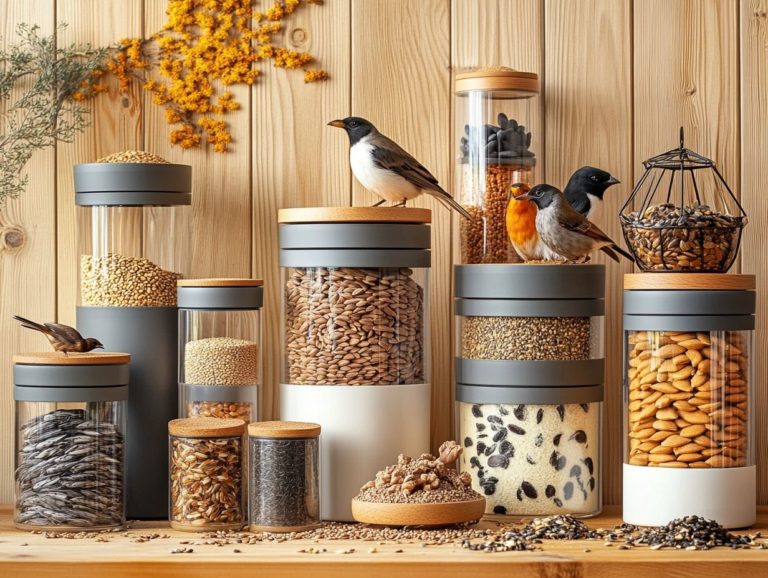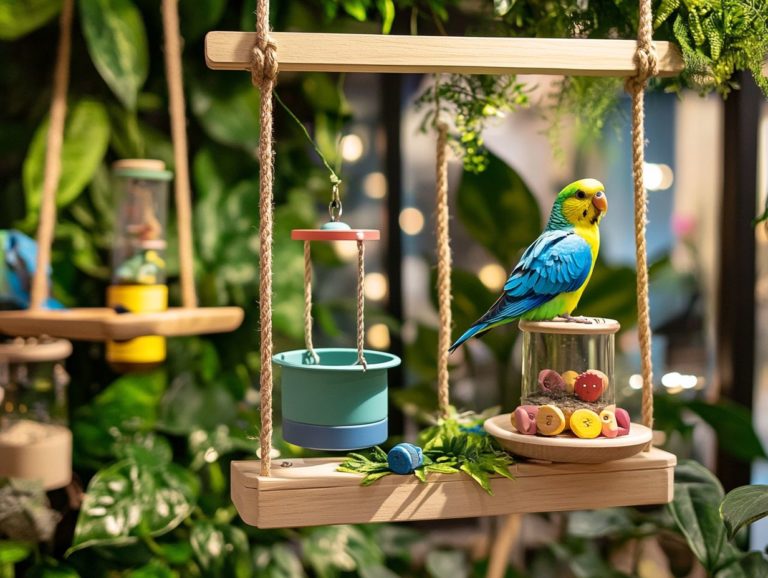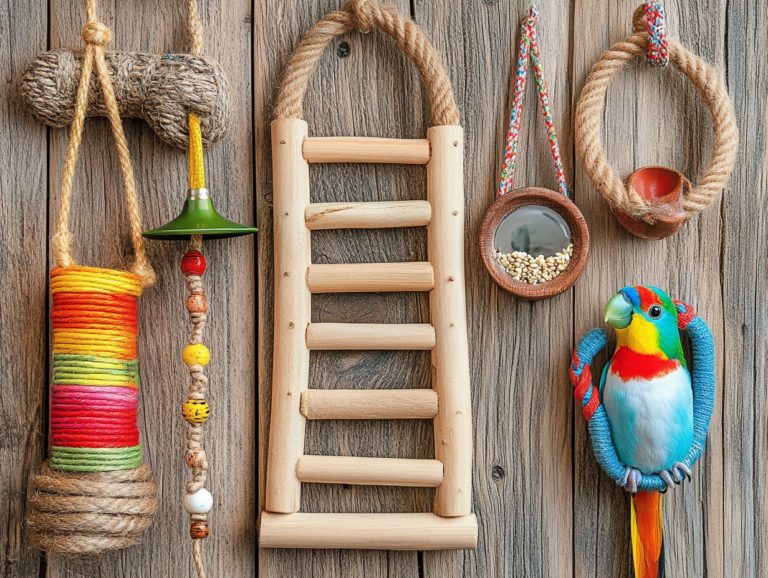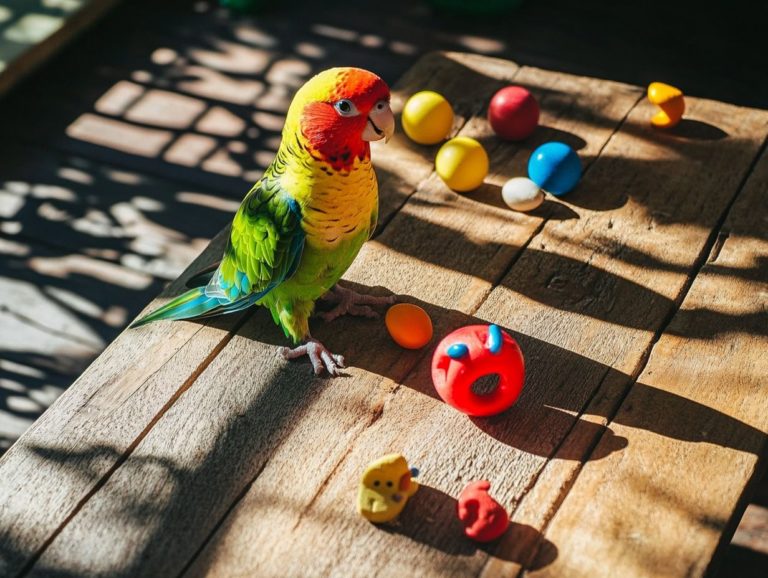Understanding Bird Toy Materials and Safety
Birds are playful and intelligent creatures that thrive on stimulation and engagement. That’s why foraging toys and chewing toys are essential for their lives.
Explore the wide array of parrot toys available, learn about the materials they’re crafted from, and discover how to choose safe options for your feathered friend.
You’ll uncover signs of unsafe toys and gain valuable tips for care and maintenance, ensuring your pet birds remain healthy and happy.
If you re the crafty type, there are exciting ideas for making toys that are both fun and safe for your feathered friends.
Get ready to transform your bird’s space into a fun paradise! Enrich your bird’s environment in delightful ways, fostering environmental enrichment and cognitive enrichment for their overall well-being!
Contents
Key Takeaways:
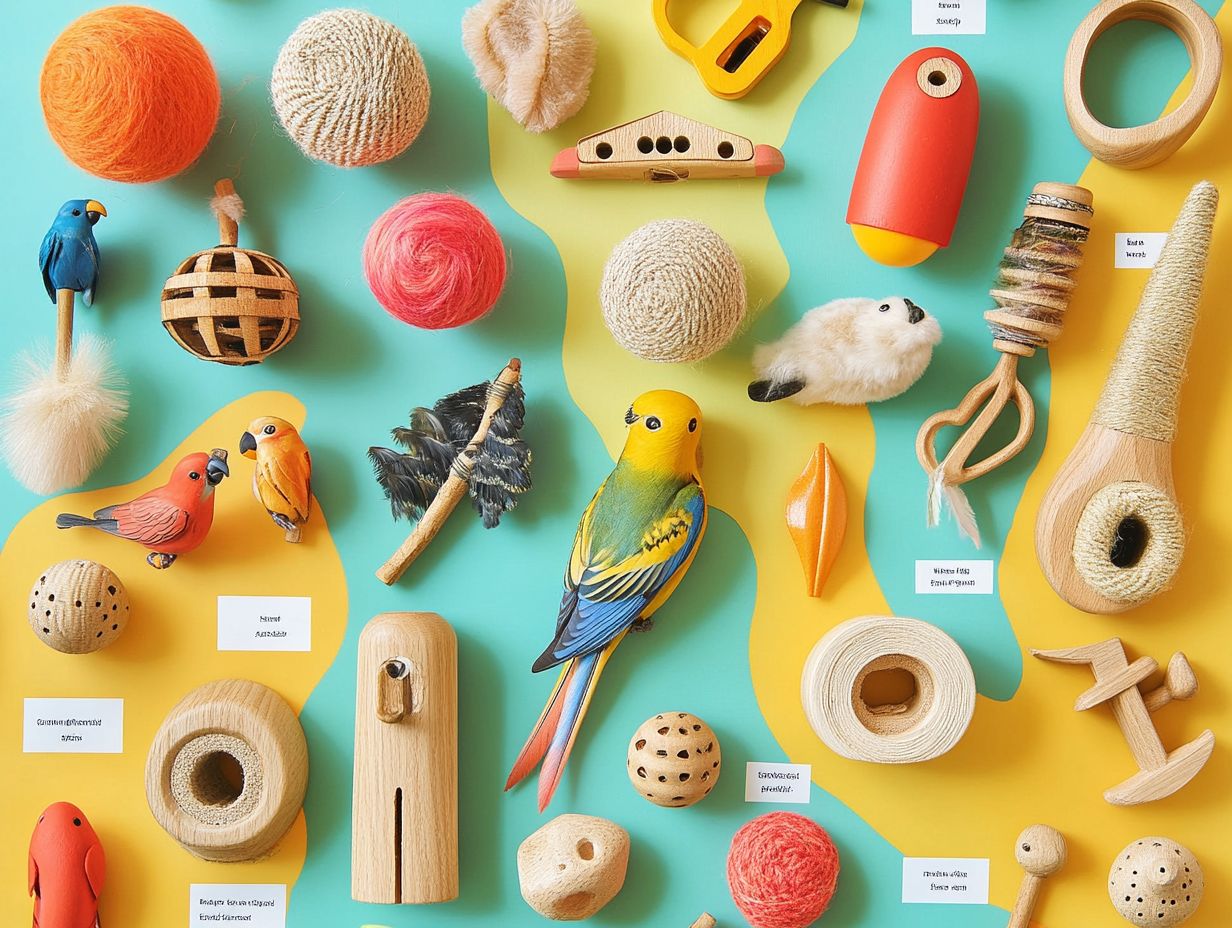
- Understand different categories of bird toys.
- Consider the pros and cons of common wood and metal types.
- Prioritize safety based on size, durability, and hazards.
Types of Bird Toys
Understanding the various types of bird toys is crucial for bird parents who want to improve their birds’ mental activity and overall well-being. With many options available, each toy is thoughtfully designed to cater to different aspects of a bird’s natural behavior.
From foraging toys that promote mental stimulation to physical exercise gear like swinging toys and mechanical toys, choosing the right type can greatly enhance your pet birds’ quality of life. Toys designed for preening provide comfort, while interactive toys ensure your birds remain engaged and entertained.
Categories of Bird Toys
Bird toys include foraging, chewing, preening, and comfort toys, each serving a unique purpose for your pet bird.
Recognizing the significance of these toys can dramatically enhance your bird’s quality of life, reducing behavioral problems and promoting stress relief. Foraging toys encourage natural behavior, promoting both physical activity and mental stimulation as your feathered friend works to uncover hidden treats. Chewing toys help maintain healthy beaks and provide an outlet for natural chewing instincts, preventing destructive habits and behavioral issues. Preening toys mimic natural textures, allowing your bird to engage in essential preening activities crucial for their emotional health.
Together, these toys are invaluable in reducing boredom and stress, contributing to a happier, healthier companion.
Common Materials Used in Bird Toys
When selecting bird toys, it s essential to consider the materials. Be sure to avoid toxic materials like lead and zinc, as they significantly impact the health and safety of your feathered companions. You’ll find a range of materials, including various types of wood and metal, but it’s vital to steer clear of toxic options like lead and zinc to ensure pet safety.
Opt for non-toxic materials, such as stainless steel and natural fibers, to guarantee the toys are safe for your beloved birds and promote their physical health. By understanding these materials, you enable yourself to make informed choices that enhance both the physical health and emotional well-being of your pets.
Choose the right toys today and keep your feathered friend healthy and happy!
Pros and Cons of Different Materials
Each type of material used in bird toys has its own set of pros and cons, significantly influencing the safety of your feathered companions and their overall behavioral well-being. To ensure the best choices, it’s important to consider understanding your bird’s play style and toys.
When evaluating your options, delve into the distinct properties of wood and metal. For example, wood provides natural chewing satisfaction and has a pleasing aesthetic. However, be cautious with untreated varieties that may conceal harmful substances, which can lead to serious behavioral problems.
On the other hand, certain metals offer impressive durability and resistance to wear. Yet, they can pose risks if toxic coatings are present, affecting pet health. Choose non-toxic materials to keep your birds safe and create a healthy living environment that promotes their emotional well-being.
Harmful substances can greatly affect their well-being, and in turn, the joy they bring to you as a pet owner.
Choosing Safe Bird Toys
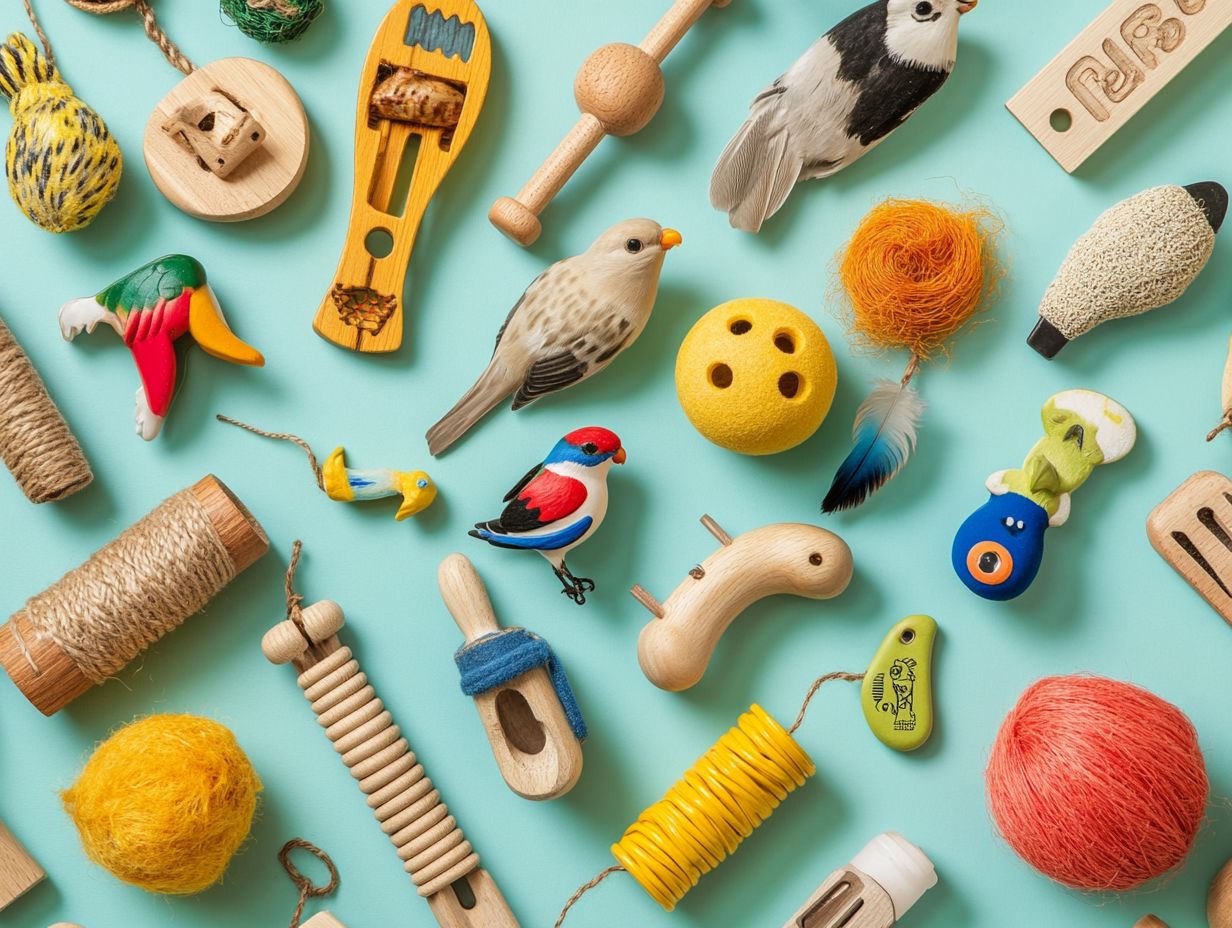
Choosing safe bird toys is a crucial responsibility for every bird parent. It directly influences the physical and emotional well-being of your feathered companions, helping to avoid anxiety and stress.
When selecting toys, conduct a thorough inspection for potential hazards like sharp edges or toxic materials. Prioritize toys that promote cognitive stimulation to help prevent boredom-related behavioral problems.
By learning how to select safe toys, you enhance your birds’ quality of life and create a nurturing environment that encourages play and exploration.
Factors to Consider
When selecting safe bird toys, several key factors demand your attention. These ensure the well-being of your feathered companions.
Consider the size of the toy carefully; it should be suitable for your bird’s breed to avoid any choking risks. An oversized toy might discourage play, while one that’s too small could create a choking hazard.
Durability is critical; natural materials like wood and cotton tend to withstand the enthusiastic beaks and claws of lively birds far better than synthetic alternatives.
Focus on toys that stimulate natural behaviors such as chewing, climbing, and foraging toys. Foraging toys are those that encourage birds to search for treats or food, promoting physical exercise and mental stimulation.
Signs of Unsafe Bird Toys
Recognizing the signs of unsafe bird toys is crucial for ensuring the safety and well-being of your beloved pet birds. Look for indicators like excessive wear and tear, sharp edges, or small parts that could easily be swallowed.
Be vigilant in inspecting bird toys for toxic materials or any signs of degradation that could pose hazards to your pet’s health. Understanding these warning signs helps protect your feathered companions from dangers that could compromise their safety.
Identifying Potential Hazards
Identifying potential hazards in bird toys is essential for ensuring the safety of your feathered friends. Some toys can present serious risks that affect pet safety.
Thoroughly examine each item before introducing it into your pet bird’s environment, especially mechanical and interactive toys. Certain materials might contain harmful toxins such as lead or zinc, leading to significant health issues if ingested. Also, small parts like bells or clips from DIY toys can create choking hazards.
Choosing toys that are appropriately sized for your specific bird species is equally important. Oversized or undersized toys can cause discomfort and lead to injury.
By being mindful of these dangers, you can create a safer play area for your avian companions, ensuring a joyful and healthy life while minimizing behavioral issues.
Caring for Bird Toys
Proper care and maintenance of bird toys are essential for promoting your pet’s health and ensuring the longevity of those delightful play items that contribute to their emotional well-being. Regularly inspecting and cleaning the toys not only prevents the buildup of harmful bacteria but also encourages your feathered companions to engage actively with their playthings.
Checking for wear and tear and replacing toys that have outlived their usefulness can significantly enhance the overall quality of life for your birds.
Proper Cleaning and Maintenance
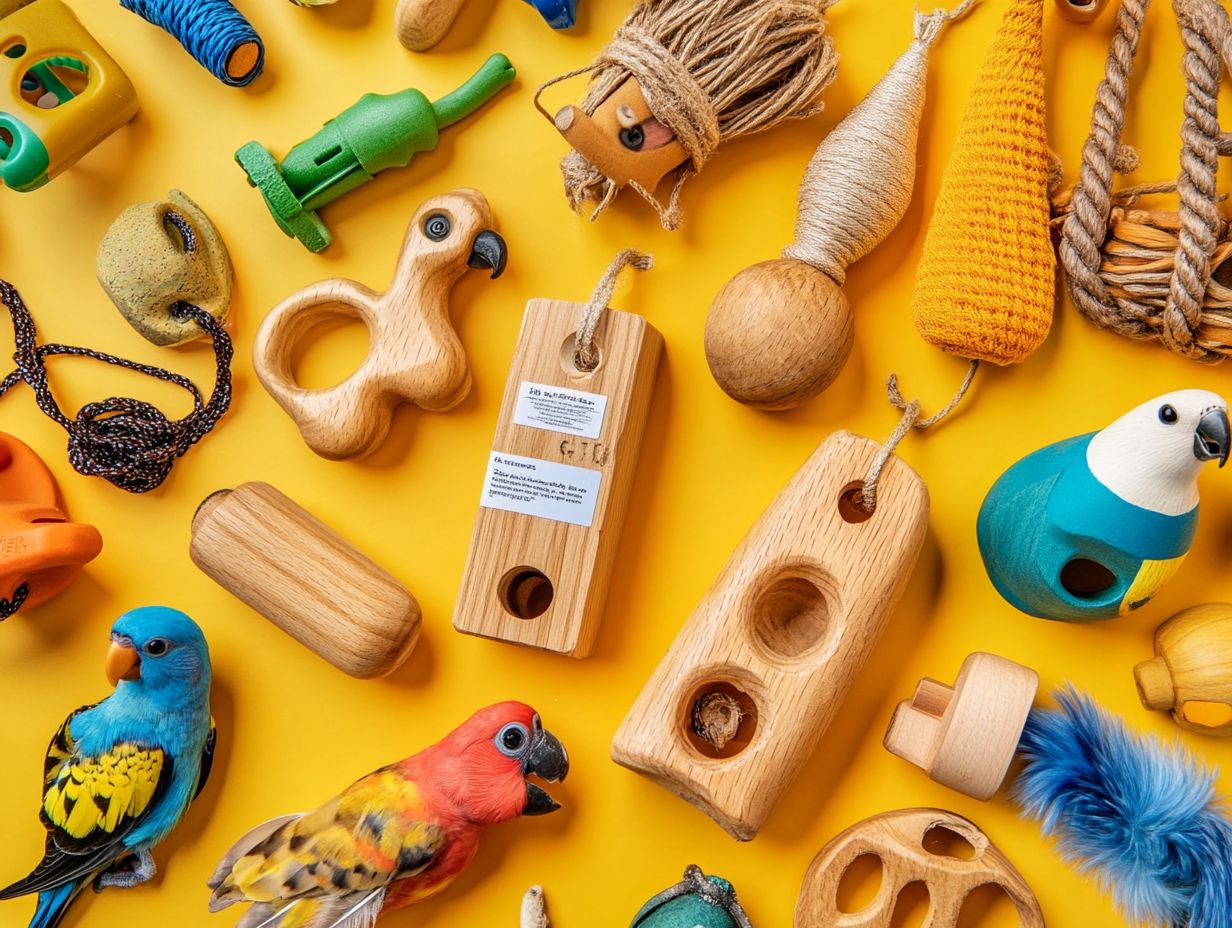
Cleaning and maintaining bird toys is crucial for your feathered companions’ physical health and emotional well-being.
Inspecting these toys for damage is key to their longevity. Damaged toys can create safety hazards and lead to potential behavioral problems.
To keep them in pristine condition, use non-toxic cleaning solutions to avoid toxic materials that could harm your birds. This eliminates bacteria and preserves the materials, ensuring your bird toys remain safe for interactive play.
Rotating the toys frequently adds an element of mental challenge, helping to prevent boredom and encouraging active engagement for your pet birds.
Keeping all toys free from harmful chemicals fosters a healthier environment. This contributes to your pet’s overall emotional stability and promotes their cognitive enrichment.
Establishing a consistent routine for cleaning and maintenance is essential. This can enhance both the lifespan of the toys and the happiness of your beloved bird, ensuring their physical health and emotional well-being.
DIY Bird Toys
Crafting DIY bird toys is a rewarding endeavor for bird parents like you. It offers a way to provide interactive and stimulating playthings that align with your pet birds natural behaviors, enhancing their cognitive enrichment.
By selecting safe materials like untreated wood and natural fibers you can create toys that captivate your feathered companions while fostering cognitive enrichment and providing emotional comfort.
The beauty of making toys at home lies in the customization. This allows you to tailor each play item to meet the unique needs and preferences of your cherished pet birds, enhancing their well-being.
Creating Safe and Fun Toys at Home
Making safe and fun toys at home is a thrilling way to bond with your birds while prioritizing their safety and happiness.
These DIY projects provide mental stimulation for your feathered friends and allow you to unleash your creativity. There’s nothing quite like the joy of watching a bird interact with a toy crafted just for them, deepening the bond between you and your avian companions.
When crafting these interactive toys, choose materials that are non-toxic and free from harmful chemicals. Opt for elements like untreated wood, natural fibers, and safe plastic components to ensure safety while keeping playtime fun.
Each toy can be customized to meet the specific needs and interests of your birds, offering endless entertainment and opportunities for physical activity.
Frequently Asked Questions
What materials are safe for bird toys?
The most common materials include wood, plastic, metal, natural fibers, and paper.
Why is it important to understand bird toy materials and safety?
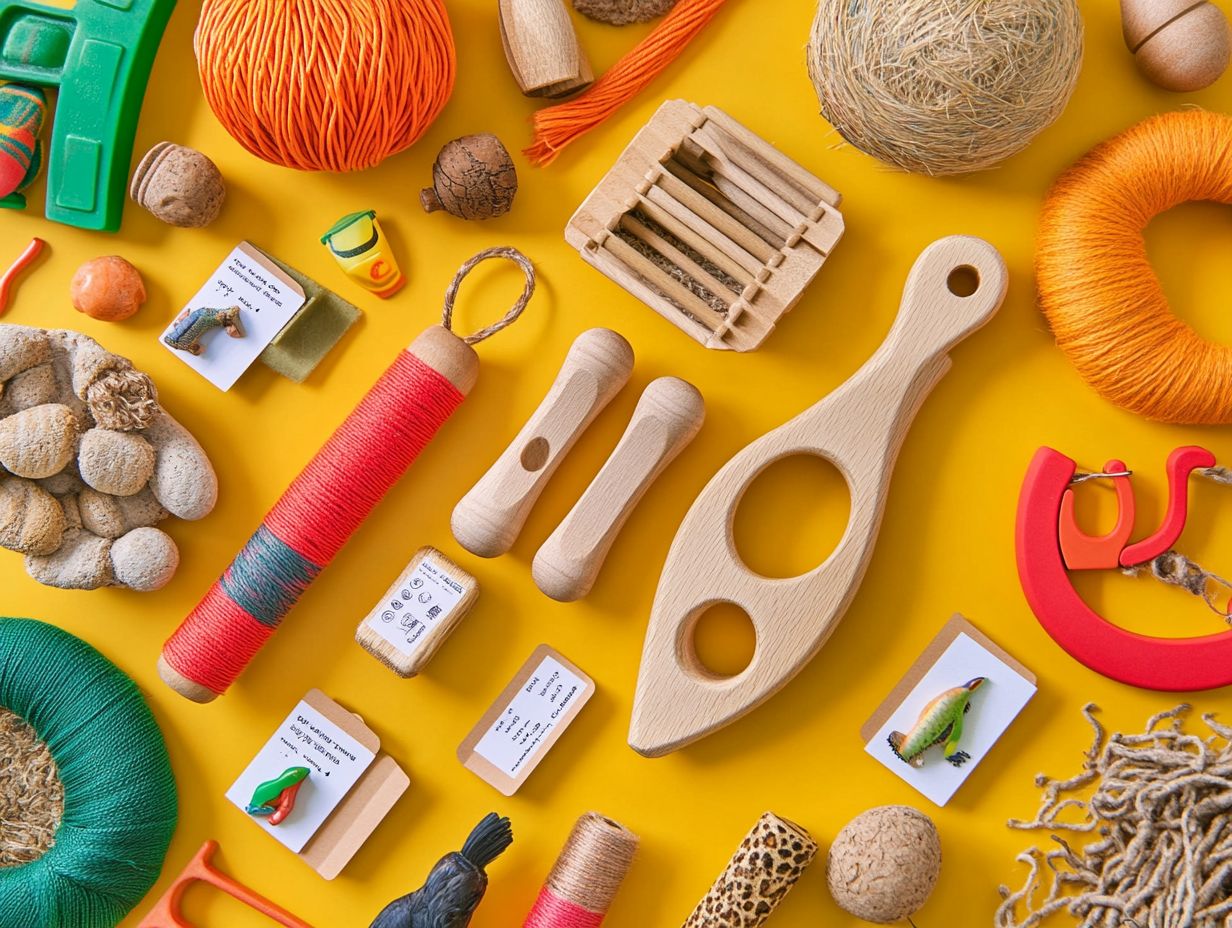
Understanding bird toy materials and safety is crucial. Certain materials can be harmful to birds if ingested, and the dangers of bird toys that are not made properly can pose a significant risk to your bird’s health and well-being.
Start crafting today and bring joy to your feathered friends!
What materials should I avoid for bird toys?
Avoid lead, zinc, and toxic chemicals like formaldehyde or BPA. Also, steer clear of materials that can break easily, like small plastic pieces or sharp metal edges.
How do I ensure my bird’s toys are safe?
Regularly check your bird’s toys for wear and tear. Avoid harmful materials and buy from trusted sellers who focus on bird safety.
What natural materials are safe for bird toys?
Yes! Safe options include untreated wood, bamboo, seagrass, and coconut shells. These materials are non-toxic and enrich your bird s environment.
Can I create bird toys at home?
Absolutely! You can craft bird toys using safe materials like untreated wood, paper, and natural fibers. Just remember to follow safety tips and check for damage often.
